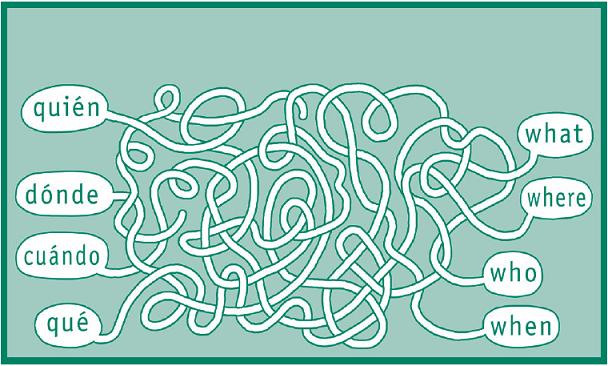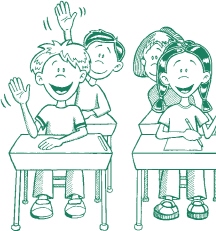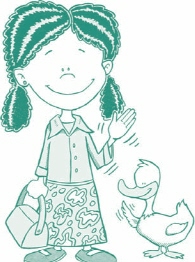
When you are talking to adults, you probably don’t call them by their first names, right? Instead, you use a title plus their last name. For example, you might call your teacher Mr. Smith. Well, it’s the same thing in Spanish:
| English | Spanish | Spanish abbreviation |
| Mr. | Señor | Sr. |
| Mrs. | Señora | Sra. |
| Miss | Señorita | Srta. |
| Dr. | Doctor | Dr. |
| Doctora | Dra. | |
| Teacher | Profesor | Prof. |
| Profesora | Profa. |
So, if your neighbor is named Mr. Grant, you would call him Señor Grant. If your Spanish teacher is named Mrs. Juárez, you would call her Profesora Juárez. It’s that easy!
Questions—Preguntas
Just like in English, you can ask “yes or no” questions in Spanish by raising your voice at the end of any sentence. Try it with the following questions:
| English | Spanish |
| Is Miguel ready? | ¿Está listo Miguel? |
| Are you thirsty? | ¿Tienes sed? |
Questions that don’t have a yes or no answer are a little different. They ask for information, like who, what, when, where, why, and how:
Consejo
IMPORTANT TIP
¡CUIDADO!
Mistake to Avoid
If someone speaks to you and you don’t hear him the first time, you may say, “What?” to ask him to repeat himself. In Spanish, you can use ¿qué? when you are asking a question with “what,” like ¿Qué haces? But when you just want to say “what?” because you didn’t hear what someone said, it’s more polite to say ¿cómo?
| English | Spanish |
| who | quién |
| what | qué |
| when | cuándo |
| where | dónde |
| why | por qué |
| how | cómo |
| how much | cuánto |
To ask “who?” feels or is a certain way, just use quién plus a verb:
| English | Spanish |
| Who is ready? | ¿Quién está listo? |
| Who is thirsty? | ¿Quién tiene sed? |
Questions, Questions
Follow the lines over and under to learn who is who, and what is what!

To ask questions with the other words, use the question word plus the verb. If you want to include the subject pronoun (such as tú), put it after the verb:
| English | Spanish |
| What are you doing? | ¿Qué haces? ¿Qué haces tú? |
| When are we eating? | ¿Cuándo comemos? ¿Cuándo comemos nosotros? |
| Where is Ana? | ¿Dónde está Ana? |
Please and Thank You—Por favor y gracias
As you know, it’s always important to be polite. It’s just the same when you’re speaking Spanish, so don’t forget the magic words “please” and “thank you.”
| English | Spanish |
| please | por favor |
| pretty please | porfis, por favorcito |
| May I ... ? | ¿Puedo ... ? |
| I want | Quiero, Deseo |
| I would like | Quisiera |
| thank you | gracias |
| thank you very much | muchas gracias |
| Thank you so much! | ¡Cuánto te lo agradezco! |
| I thank you | Le doy gracias |
| you're welcome | de nada |
| don't mention it | no hay de qué |
If you accidentally bump into someone or do something wrong, the polite thing to do is say you’re sorry, right? It’s the same in Spanish. The following are some words to use when you need to excuse yourself or apologize:
¿Cómo?—
Say What?

¡CUIDADO!
Mistake to Avoid
Perdón, dispense, and con permiso are used to be polite, like when you interrupt someone or need someone to move over so that you can get by. Perdóname and discúlpame are used when you have done something wrong and are asking for forgiveness, like if you broke something or made a mess.

| English | Spanish |
| pardon me | perdón, dispense |
| excuse me | con permiso |
| forgive me | perdóname, discúlpame |
| I'm sorry | lo siento |
| I'm very sorry | lo siento mucho |
Goodbye—Adiós
Just like there are several ways to greet people in Spanish, there are also various ways to say goodbye. Here are some common phrases to use when you part ways:
| English | Spanish |
| Goodbye | Adiós |
| Bye | Chao |
| Bye-bye | Adiosito |
| See you later | Hasta luego |
| Hasta pronto | |
| Hasta la vista | |
| Catch you later! | ¡Nos vemos! |
| See you tomorrow | Hasta mañana |
| See you next week | Hasta la semana próxima |
| Have a nice day | Que tengas un buen día |
| Que pases un buen día | |
| Good night | Buenas noches |
There are also some expressions that are only used for special kinds of goodbyes.
When someone is leaving on a trip, you can say ¡Buen viaje! (Have a good trip!)
If your friend is taking a test, competing, or doing something else difficult, you can say ¡Buena suerte! (good luck!) or ¡Que te vaya bien! (I hope it goes well!)
When saying goodbye to someone they don’t expect to see again for a long time, some Spanish speakers might say Vaya con Dios (Go with God).
Conversations—Conversaciones
Now that you know all this new vocabulary, it’s time to practice with a friend! Here is a sample conversation to help you get started:
| Speaker | English | Spanish |
| JAIME | Hello. | Hola. |
| LUPE | Hello. What's your name? | Hola. ¿Cómo te llamas? |
| JAIME | My name is Jaime, and you? | Me llamo Jaime, ¿y tú? |
| LUPE | My name is Lupe. | Me llamo Lupe. |
| JAIME | It's nice to meet you. | Mucho gusto. |
| LUPE | Same here. | Igualmente. |
| JAIME | How are you? | ¿Cómo estás? |
| LUPE | Fine, and you? | Bien, ¿y tú? |
| JAIME | Same here. | Igualmente. |
| LUPE | Goodbye, Jaime. | Adiós, Jaime. |
| JAIME | Goodbye. | Adiós. |
Here’s another conversation. This one is between a boy named Miguel and his teacher, Mrs. López:

Consejo
IMPORTANT TIP
| Speaker | English | Spanish |
| MIGUEL | Good afternoon, Mrs. López. | Buenas tardes, Señora López. |
| SRA. LÓPEZ | Good afternoon, Miguel. | Buenas tardes, Miguel. |
| MIGUEL | How are you? | ¿Cómo está Ud.? |
| SRA. LÓPEZ | Very good. Who is this? | Muy bien. ¿Quién es ella? |
| MIGUEL | Pardon me, Mrs. López, this is my sister. Her name is Blanca. | Perdón, Señora López, es mi hermana. Ella se llama Blanca. |
| SRA. LÓPEZ | It's nice to meet you. | Mucho gusto. |
| BLANCA | Good afternoon, Mrs. López. | Buenas tardes, Señora López. |
| SRA. LÓPEZ | Goodbye, Miguel and Blanca. | Adiós, Miguel y Blanca. |
| MIGUEL | See you tomorrow. | Hasta mañana. |